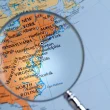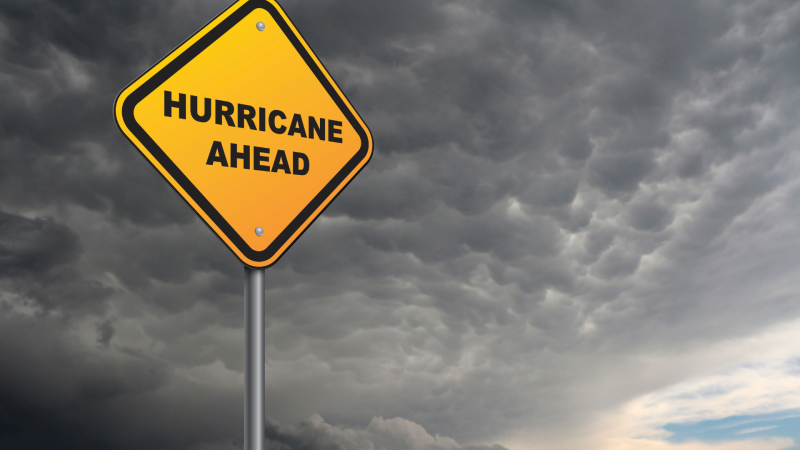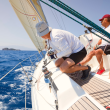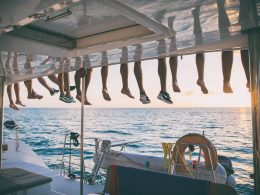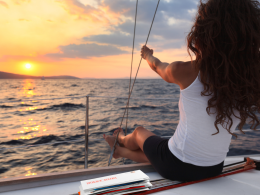Many seasoned sailors, boat owners, and liveaboards pride themselves on skillfully riding out the occasional storm. But as anyone who experienced a hurricane firsthand knows, these powerful tropical storms can be a whole different ballgame. There’s no doubt they can be life-threatening, but can you survive them on a boat? Let’s take a closer look at this crucial topic.
Is It Safe to Be on a Boat During a Hurricane?
Even for modest hurricanes, experts do not recommend riding it out on a boat. While it’s possible to safely ride out a less intense storm on your ship with careful planning, it’s typically not the best idea.
To stay safe, you’ll need a nearly ideal location with relative protection from the storm that’s not too crowded with hazards like other boats. You may also need some luck, as it’s hard to anticipate other dangers you might face on the water, particularly from other vessels that may be adrift during the worst of the storm.

Can You Outrun a Hurricane on a Boat?
The answer depends on several factors; the speed of the storm, the speed of your boat, and your relative location. Scientists have found past hurricanes have moved as fast as 60-70 miles per hour linearly as they quickly blow through an area or ground nearly to a halt at a few miles per hour.
The slower the storm, the more likely you could outrun it. However, this may be challenging or impossible with large storms, especially for those with boats in locations like the Gulf of Mexico, where natural geography can make it tough to put significant distance between you and the storm.
Additionally, outrunning a hurricane requires taking action early when it is still far away and can potentially change direction or peter out. This could mean relocating, only to find the storm missed your original spot or followed you to your new destination! Therefore, those who wait until a hurricane is bearing down on them shouldn’t attempt to outrun it. Try to hunker down instead.
HOT TIP
Sail the seven seas alongside these 10 Up and Coming Sailing YouTubers.

What Do Boat Owners Do During a Hurricane?
The proper ways to care for a boat during a hurricane will vary depending on your boat type. Regardless of the type of vessel, ensure you’re aware of any local laws or rules from your marina/boat storage that may apply during hurricanes.
Small Vessels
Those with small boats they can move on a trailer or tow have the easiest task with an approaching hurricane. These folks should take their boats out of the water and secure them as far inland as possible. Naturally, an indoor space will provide the most protection from wind and rain. Still, you should keep boats far from trees or other potential sources of damage in any case.
Yachts
Yacht owners have a more complicated task, but they also have more options. Depending on the speed and location of the storm and boat, it may be possible to relocate out of harm’s way. You can also take yachts out of the water and store them elsewhere during the storm.
Additionally, you can also secure a yacht with other vessels in a protected harbor to hopefully ride out the hurricane safely. Owners can handle these tasks or hire companies to safeguard yachts and other boats during severe weather.
Sailboats
When sailboats don’t have enough time to sail out of the hurricane’s path safely, owners should ideally look to remove their boats from the water. In addition, they should secure sails and other exterior items and take steps to keep as much water out of the boat as possible.
Experienced sailors can also attempt to ride out the storm in their boats in “hurricane holes.” These are areas protected from some of the high winds and surging tides that accompany a hurricane. They’ll need to securely anchor and watch to ensure things stay safe from debris or other boats during the peak of the storm.

What Happens If You’re in the Ocean During a Hurricane?
Those on the ocean during a hurricane will experience various unpleasant and potentially life-threatening effects. Winds can produce incredibly powerful consequences with nothing to stop them.
Intense storms can create massive waves that threaten even the most seaworthy vessel. In addition, in the open ocean, it may be difficult to anchor. This can make it impossible to control your location as you drift. Overall, it’s not an experience we recommend if you can avoid it.
What Do Liveaboards Do During Hurricane Season?
Hurricane season plans for those living full-time on their boats are as varied and diverse as the liveaboards themselves! Some will choose to sail to other areas that are less hurricane-prone. They’ll continue their normal lifestyle while reducing their risk and getting a nice change of scenery.
Others may store their boats for weeks or months, perhaps staying with family or friends or finding a short-term rental. The most dedicated and adventurous liveaboard boaters may continue as usual, even in areas known for hurricanes. They must constantly watch the weather forecast and be ready to take action if a storm is spinning nearby.
HOT TIP
Don’t know if the liveaboard life is right for you? Uncover The Truth About Living on a Boat vs. Full-Time RV Life.

Where Are Hurricanes Most Prevalent?
Two regions of the world are most at risk of hurricanes or other tropical storms; eastern and southeastern Asia and the areas surrounding the Caribbean and Gulf of Mexico. In our hemisphere, island nations see the strongest and most frequent impacts, with the United States not far behind.
Domestically, hurricanes most commonly strike Florida, which is vulnerable on both coasts. It is followed by other Gulf Coast states like Louisiana, Texas, Alabama, and Mississippi. However, it’s vital to realize that hurricanes can strike anywhere along the east coast.
Hurricane/Superstorm Sandy proved this by devastating New Jersey and New York in 2012. The west coast of the United States can also see impacts, though it’s much rarer due to cooler water temperatures.
When Is Hurricane Season?
Those living and sailing in the Americas should focus primarily on the Atlantic hurricane season. This season runs from June through November. However, climate data shows the actual peak occurs between mid-August and mid-October.
The reason for this is because waters are typically much warmer thanks to weeks or months of heating from the summer sun. These warm waters provide more energy to developing storm systems, creating more hurricanes.
The familiarity of names like Ian, Katrina, Andrew, and Sandy testify to the incredible destructive power hurricanes can bring. Well ahead of the start of hurricane season, those living full-time or spending extended periods on their boats should have a plan. While many storms won’t pose any threat, those living in areas prone to hurricanes may only have days or hours to act when one bears down.
Do you have a hurricane contingency plan?
If You Love RVing, You Need to Stay Informed
Don’t rely on biased RV industry news sources to keep you informed with RVing news.
Stick with Nomadic News. We publish daily articles and breaking stories that matter to your RV lifestyle.

